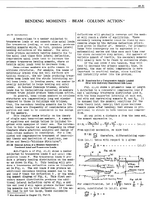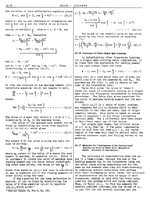oriolbetriu
New member
Hi!
I am trying to learn how to calculate secondary moment, so that I can analize properly any strutted wing. I am following Bruhn's example, please see pages below. I think that I understand, the way the formulas are deduced from the force diagram, which ends up in a secondary order differential equation;
d^2M/dx^2 + 1/J^2*M = W
Which can be rewritten as;
d^2M/dx^2 + 1/J^2*M - W = 0
or;
y´´ + 1/J^2 + 1/J^2*y - W = 0
Solving this equation is sort of trivial. Because the roots of the differential equation can be solved, as if the equation was a second degree polinomy;
(-b +-(b^2 - 4*a*c)^(1/2))/(2*a) = (-(1/J^2) +-((1/J^2)^2 - 4*1*W))^(1/2)/(2*1)
If we look inside the root the value is positive, because (-4)*(-W) is positive, therefore the solution ought to be in the form of;
M = C1*e^(r1*alfa) + C2*e^(r2*alfa)
However Bruhn gives as the solution of the differential equation, the form that is used for imaginary numbers;
M = C1*sin(x/j) + C2*cos(x/j)
How is that so?! I can not tell what I am missing? I am stuck with this, and unable to advance. I never finished my aero studies, and I do not know anyone in my close circle, with whom I can discuss such things.
Any advice will be greatly appreciated!
Oriol


I am trying to learn how to calculate secondary moment, so that I can analize properly any strutted wing. I am following Bruhn's example, please see pages below. I think that I understand, the way the formulas are deduced from the force diagram, which ends up in a secondary order differential equation;
d^2M/dx^2 + 1/J^2*M = W
Which can be rewritten as;
d^2M/dx^2 + 1/J^2*M - W = 0
or;
y´´ + 1/J^2 + 1/J^2*y - W = 0
Solving this equation is sort of trivial. Because the roots of the differential equation can be solved, as if the equation was a second degree polinomy;
(-b +-(b^2 - 4*a*c)^(1/2))/(2*a) = (-(1/J^2) +-((1/J^2)^2 - 4*1*W))^(1/2)/(2*1)
If we look inside the root the value is positive, because (-4)*(-W) is positive, therefore the solution ought to be in the form of;
M = C1*e^(r1*alfa) + C2*e^(r2*alfa)
However Bruhn gives as the solution of the differential equation, the form that is used for imaginary numbers;
M = C1*sin(x/j) + C2*cos(x/j)
How is that so?! I can not tell what I am missing? I am stuck with this, and unable to advance. I never finished my aero studies, and I do not know anyone in my close circle, with whom I can discuss such things.
Any advice will be greatly appreciated!
Oriol


